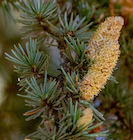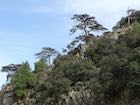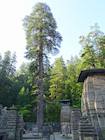
Foliage, unripe, ripe, and dehiscent cones, and a cone axil, on an ornamental specimen in Seattle (USA) [C.J. Earle, 2019.07.13].

Foliage and recently-ripe pollen cones on C. atlantica in habitat, Middle Atlas, Morocco; iNaturalist observation 17251044 [Shawn O'Donnell, 2018.10.04].

Cedrus atlantica in habitat, Middle Atlas, Morocco; iNaturalist observation 56884771 [Guenther Eichhorn, 2018.04.26].

Native forest with Cedrus brevifolia in western Cyprus [Grzegorz Grzejszczak, 2020.03.19, Facebook post].

The giant Cedrus deodara at an ancient temple complex in the Jageshwar Valley, India (elev. 1870 m). The girth of the tree is between 9-10 m [Gaurav Verma, 2019.04].

The Cedars of God Bsharri forest in snow, Lebanon; iNaturalist observation 40168974 [Rytis, 2019.04.12].

Cedrus
Trew 1757
Common names
Cedar [English]; Κέδρος [Greek]; الأرز [Arabic]; cedro [Italian, Spanish]; ཐང་ཁྲག [Tibetan]; sedir [Turkish]. A great many species in the Cupressaceae are also commonly referred to as cedars (in English), so species of Cedrus are sometimes called 'true cedars'.
Taxonomic notes
A genus of four species:
Cedrus deodara of the Himalaya is generally agreed to be sister to a clade containing the other three taxa, which are Mediterranean. Those taxa are here treated as species, although some authors have chosen to treat them all as infraspecific taxa of Cedrus libani. Nonetheless, molecular analyses have found consistent differences between the species of Cedrus. One study found C. atlantica sister to a clade of C. libani and C. brevifolia, with an estimated divergence between the eastern and western Mediterranean taxa at about 23 million years ago, and a divergence between C. libani and C. brevifolia about 5.3 to 10.5 million years ago (Qiao et al. 2007). Another study, using a new set of nuclear microsatellite markers, largely confirmed these results but identified Lebanese C. libani as more similar to C. brevifolia than to Turkish C. libani (Karam et al. 2019).
Description
Monoecious evergreen trees with a columnar trunk. Crown broad with erect or bent top. Branches not in whorls. Young trees branching at regular intervals, later several branches of the first order become codominant with the main stem, except in C. deodara, where the apical dominance is maintained (Massart model). There are resin canals in bark, leaves, and seed cones, and resin cysts in wood. Bark on young trees smooth and gray, eventually becoming longitudinally furrowed and scaly, dark gray. Shoot dimorphism pronounced, with long, slender leading shoots and lateral, short spur shoots; a terminal bud forming a long shoot, and several lateral buds forming short shoots. Leaves persisting for 3-6 years, linear-acicular, stiff, usually slightly narrowed near base and tapering towards an acute apex, amphistomatic, quadrangular. Pollen cones solitary and more or less erect from apex of short shoots, large (3-5 cm long), catkin-like; pollen bisaccate. Seed cones terminal on short shoots, sessile, erect, requiring about 17-18 months for full development, becoming ovoid to barrel-shaped when full grown. Bracts small and hidden, not growing with the seed scales. Seed scales helically arranged on a narrowly conical rachis and extremely imbricate, large, flabellate, coriaceous or thin woody, dismembering from the persistent rachis by abcission at maturity, the rachis not deciduous. Seeds fully covered by a membrane on one side and partly covered with a small portion at other side, membrane continuing in a large, broad seed wing. Seedlings with (5-)8-10(-14) cotyledons. Chromosomes n=12 (Vidakovic 1991, Farjon 2010).
Distribution and Ecology
Mountains of the W and E Mediterranean, and the W Himal (Vidakovic 1991). The reasons for this disjunct range are not yet clear, but a wide variety of plants have close-relative linkages between the Mediterranean and the Himalaya.
Cedars of the Mediterranean; C. atlantica in blue, C. brevifolia in yellow, and C. libani in orange (see C. deodara for a distribution map of that species). Distribution data from GBIF, 2021.02.17 and 2021.02.18.
Remarkable Specimens
Cedrus deodara attains sizes over 450 cm DBH, the largest stem diameter recorded in the Pinaceae. Both C. atlantica and C. deodara also attain great sizes, with multiple specimens larger than 200 cm DBH. Three species vie for the tallest specimen: 45 m for C. deodara, 43 m for C. libani and 43.8 m for C. atlantica. Given the paucity of data, any of these species may qualify as the tallest, though I would favor C. deodara due to its presence in some habitats that have adequate precipitation throughout the year, thus a low risk of drought stress.
There are few age data for any of the species, and as is often the case, the oldest ages have the lowest reliability. It seems that C. deodara may attain 900 years. Great ages are attributed to C. atlantica and C. deodara, seemingly without any supporting data, but this is common for trees that attain great size.
Ethnobotany
All species have a history of use in construction and cabinetry, but overexploitation and rarity is rapidly ending that era for the Mediterranean species, although C. atlantica is sometimes planted for timber production. All species are widely planted as ornamentals (C. brevifolia less than the others) in temperate areas. C. libani probably has the greatest cultural importance, having been used and revered within its range for millennia; it has the longest written record of human use of any conifer.
Some dendrochronology studies have been done with C. atlantica, C. brevifolia and C. deodara. As of 2021, I have found no records of work with C. brevifolia.
Observations
See the species accounts. All species are widely planted in arboreta and botanical gardens, and are reasonably accessible in habitat.
Remarks
Κέδρος is the Greek name for a resinous tree (Vidakovic 1991).
Citations
Karam, Marie-Joe, Monique Aouad, Anne Roig, Audrey Bile, Magda Bou Dagher-Kharrat, Etienne K. Klein, Bruno Fady, and François Lefèvre. 2019. Characterizing the genetic diversity of Atlas cedar and phylogeny of Mediterranean Cedrus species with a new multiplex of 16 SSR markers. Tree Genetics & Genomes, https://doi.org/10.1007/s11295-019-1366-1.
Qiao, C.-Y., J.-H. Ran, Y. Li, and X.-Q. Wang. 2007. Phylogeny and biogeography of Cedrus (Pinaceae) inferred from sequences of seven paternal chloroplast and maternal mitochondrial DNA regions. Annals of Botany 100:573–580.
Trew, C.J. 1757. Cedrorum libani historia cum illo Laricis, Abietus Pinique comparatus. Nurnberg.
See also





